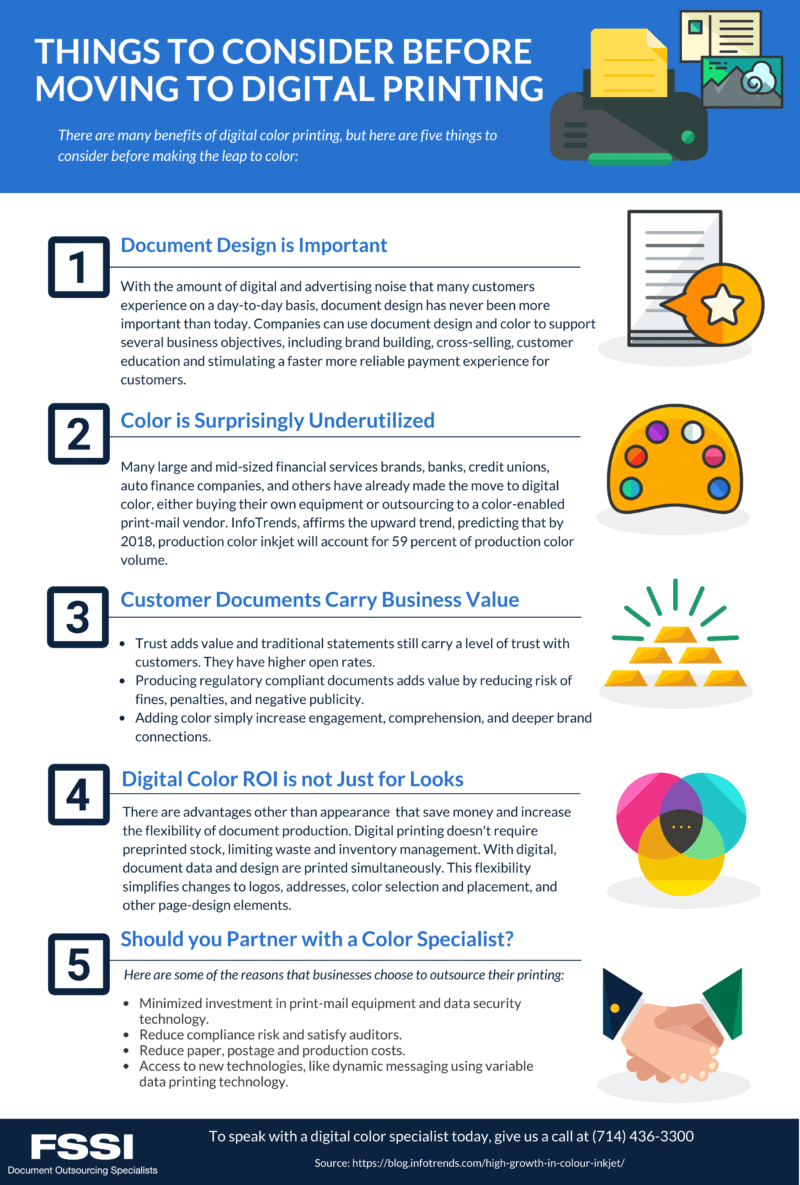Some Known Incorrect Statements About Digital Printing
The 9-Minute Rule for Digital Printing
Table of ContentsSee This Report about Digital PrintingThe Single Strategy To Use For Digital PrintingThe Buzz on Digital PrintingThe Single Strategy To Use For Digital PrintingSome Known Incorrect Statements About Digital Printing The Main Principles Of Digital Printing
Variable information printing, such as direct mail with customized codes and addresses, is preferably fit for electronic printing. Digital quick printing just needs 4 steps of layout, testimonial, printing and binding to get everything done. Digital quick printing has an unrivaled benefit: print on demand.According to PMMI, digital printing permits brands and suppliers to respond swiftly to customer needs while enhancing the supply chain, minimizing warehousing cost and waste, and taking pleasure in faster time to market. That all sounds excellent, but just how does this modern technology do all that? The major differentiator of these modern technologies is that there are no set-up costs and no plates with digital printing.
The Ultimate Guide To Digital Printing
According to Wikipedia, the best difference between digital printing and traditional approaches such as lithography, flexography, gravure, or letterpress - Digital Printing is that there is no need to replace printing plates in electronic printing, whereas in these analog printing approaches the plates are consistently changed. This leads to quicker turnaround time and reduces cost when using digital printing.
Quick manufacturing means obtaining your product to market much faster. It additionally means it's easier and faster to make changes later, when you transform a recipe, add a SKU, or create seasonal product packaging. Digital printing is very adaptable, so it's easy to make adjustments to the bundle style swiftly. All of it returns to the plates.
Extra supply can imply more waste later on. With conventional printing approaches, short-run printing is just not possible. Because a great layout can make or break your product, electronic printing consistently develops top notch, clear and colorful graphics each time. Digital printing on flexible bags includes the bright, dynamic, and exact graphics that practically beckon customers to get to out and touch them.
Digital printing is the procedure of printing digital-based images straight onto a range of media substrates. There is no need for a printing plate, unlike with balanced out printing. Digital data such as PDFs or desktop publishing documents can be sent straight to the digital printing press to publish theoretically, photo paper, canvas, textile, synthetics, cardstock and various other substrates.
Facts About Digital Printing Revealed
According to PMMI, digital printing allows brands and makers to respond swiftly to customer needs while improving the supply chain, decreasing warehousing price and waste, and taking pleasure in faster time to market. That all noises terrific, yet exactly how does this innovation do all that? The significant differentiator of these technologies is that there are no set up costs and no plates with electronic printing.
According to Wikipedia, the best distinction between digital printing and traditional techniques such as lithography, flexography, gravure, or letterpress is that there is no need to change printing plates in electronic printing, whereas in these analog printing methods home plates are continuously replaced. This results in quicker turnaround time and decreases cost when using electronic printing.

The Best Guide To Digital Printing
More supply can mean even more waste later on. With standard printing techniques, short-run printing is simply not possible. Due to the fact that a fantastic design can make or break check my reference your item, electronic printing regularly creates top quality, clear and vibrant graphics each time. Digital printing on adaptable pouches includes the bright, vibrant, and precise graphics that practically beckon consumers to connect and touch them.

According to PMMI, electronic printing allows brands and makers to react promptly to consumer demands while enhancing the supply chain, minimizing warehousing cost and waste, and appreciating faster time to market. That all Learn More audios excellent, however exactly how does this technology do all that? The major differentiator of these modern technologies is that there are no set up costs and no plates with digital printing.
The Buzz on Digital Printing
This results in quicker turnaround time and lowers cost when utilizing electronic printing.
Speedy production suggests obtaining your product to market faster. It likewise suggests it's easier and faster to make changes later, when you transform a dish, add a SKU, or create seasonal product packaging. Digital printing is very versatile, so it's simple to make adjustments to the package style swiftly. All of it returns to the plates.

The 2-Minute Rule for Digital Printing
Digital printing is the process of printing digital-based images directly onto a selection of media substratums. There is no requirement for a printing plate, unlike with balanced out printing. Digital documents such as PDFs or desktop publishing files can be sent straight to the electronic printing machine to publish on paper, photo paper, canvas, textile, synthetics, cardstock and various other substrates.